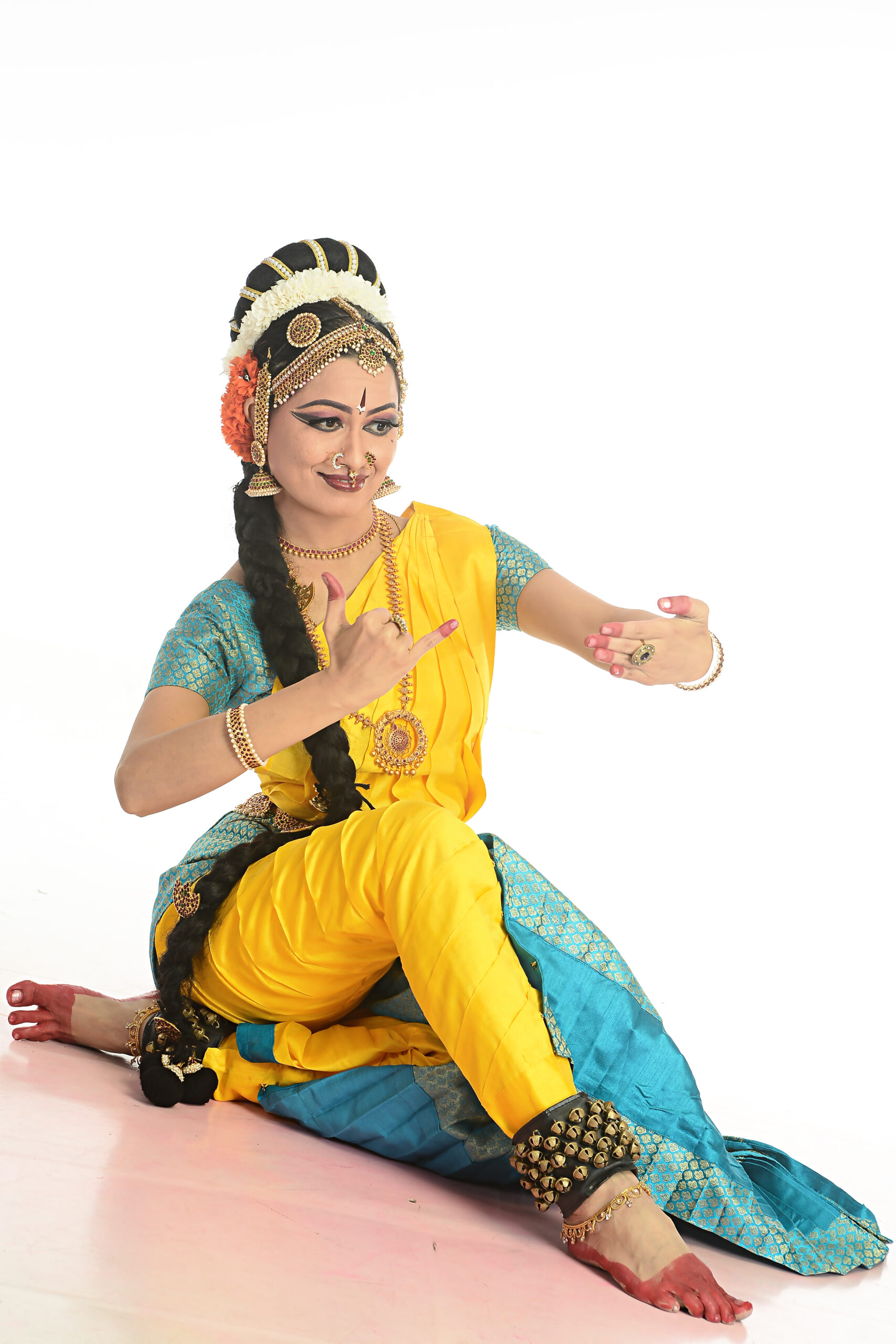On a comprehensive examination of Bhāmākalāpaṁ, one can find several distinctive fragments, one of which is patralēkha which captures the delicate expressions of love and pain. There are several references to similar letters in epics and Rukmini’s letter to Krishna from Pōtana Bhāgavataṁ is one that received great admiration. Satyabhama’s letter in Bhāmākalāpaṁ too got such acclaim in the context of dance dramas.
The lekha is composed in a harmonious prose (cūrṇika) of rich metaphors that succinctly exhibits the agonised state of Satyabhama longing to meet her beloved. Satyabhama, in a state of virahōtkaṇṭhita, entrusts the female messenger (duti) Madhavi to speak of her condition to nayaka and obliges her to carry the letter to Krishna. Satyabhama commits traditional jewellery (yēḍu vāramula nagalu – seven sets of jewellery significant to each day of the week) to Madhavi for this favour. However, Madhavi compels Satyabhama to give away her nose ring, which is the most treasured and propitious ornament for a married woman.
Siddendra Yogi deftly employs a lexicon that is appropriate to the royalty of Krishna and Satyabhama. The letter is formally crafted that each of the segments viz. salutations, message, closing note and signature are inclusive of it.
Bhāmākalāpaṁ is a Srungara rasa kavya based on vipralamba srungara (love in separation) where one of the nayika’s states is Guna Keertana (exposition of the loved one’s qualities) and in that vein Satyabhama begins the letter with salutations by enumerating the merits of Krishna as nandanandana, mucakundavarada, mandarōd’dhara, parihasita rākāsudhākarā, sundara vadanāravinda and likens him to a honeybee that relishes in extracting nectar from the lotus like face of Satyabhama. She then appeals for his kind consideration with utmost humbleness by prostrating to the feet of Krishna (rājagōpālasvāmi vāri caraṇāravindamulaku). It is quite apparent that Satyabhama now is devoid of any arrogance which contrasts with her usual self in pravēśa daruvu.
Smriti (reminisce of the good memories) is another characteristic of vipralamba srungara niyika where she wistfully recollects the blissful moments spent with her nayaka. Satyabhama, likewise, proceeds with a nostalgic recollection of her marriage arranged by King Satrajit, probably to drive Krishna into a state of emotional provocation. She reminds Krishna as the one with divine brilliance gratifying her in his comforting embrace at the royally extravagant cot studded with most precious gems (blue and yellow sapphires, hessonite, emerald, topaz, and other highly prized diamonds) and that which has the softness of the feathers of a swan.
Satyabhama, after recalling her treasured memories of Krishna, moves on to describe her woes from the time he desolated her.
Satyabhama’s affliction due to her separation from Krishna has become so intense that the pleasant milieu, the supposed excitants (Uddipanna vibhava), that aid and arouse the erotic emotions between nayaka and nayika have even begun to cause unendurable suffering.
Satyabhama rues how the cupid (manmadha), the god of love, has become merciless and his arrows though made of flowers are piercing and shattering her heart; parrots, peacocks and other birds instead of cajoling her are now adding to her distress with their chirping and cooing; inebriated swarming bees are causing despondence; the moon has turned into blazing fire and gentle breeze has become a moribund experience.
Satyabhama laments that it is not righteous on the part of Krishna to leave her to the horrendous environment and to be obstinate against an innocent woman like her. She, therefore, pleads to have mercy and return to their abode to salvage her from the adversity and fulfil her yearnings.
Churnika ends with a kanda padyam.
చిత్తజుని బారికోర్వక
తత్తరపడి రాసినాను తప్పో ఒప్పో
చిత్తమున కోపమెంచక
ఇత్తరి బ్రోవంగ రావే ఇవియే ప్రణతుల్ చిత్తగించవలెను
……... ఇట్లు మీ ప్రాణసఖి సత్యభామ
Satyabhama concludes that she hustled in writing this letter out of overbearing pain of separation and requests him not to have any resentment for any inadvertent mistakes. With humble regards she again appeals to accept the message of returning to her.
The letter bears the signature……… “From your dearest consort Satyabhama”
Music Composition:
This lekha is tuned in Arabhi, a favorable raga that conveys Roudra rasa (fury) and in this context suitably chosen to express Satyabhama’s agony. Another interesting fact is that the popular churnika Jayathu jayathu sakala nigamagama by Tyagaraja was also set in Arabhi.
The lekha has various moods –happy recollection of the past, painful exposition of separation, earnestly pleading him to come back and abject surrender in a state of helplessness. To convey these varied moods and expressions the musician supporting on vocal should be proficient in employing the dynamics of the music by alternating between singing loud and soft and also in higher and lower octaves. These dynamics communicate particular emotional state of the piece and creates an impression on the listener’s mood. One can note the loud and high note octaves used at majjanakundu satrajithu nannu meekichi …, Marundu krurundaye… and the soft and lower note octaves while requesting him to come back to her (నా వంటి అబల యెడ చలము).
Dance being a comprehensive art derives a great deal of its support from the accompanying music. Dancer can effortlessly emote the mood of the phrase only when musician on vocal renders with such expression. Invariably, the dynamics of music reflects in the dance and that’s how the drama will leave a lasting impression on spectators when musician and dancer complement each other.
Though dutika rayabaram where the sakhi carries message to hero is common in vipralamba srungaram, the lekha in Bhamakalapam is an unusual piece where the entire content of the lekha is enacted on the stage.


అత్యద్భుతమైన భాష్యము . ప్రతి ఒక్క వాక్యమూ అమృతధారలలో ఓలలాడించి ఆనందడోలికలలో ఊగించినవి . రచయిత్రికి హృదయ పూర్వక అభినందనలు .👌👌